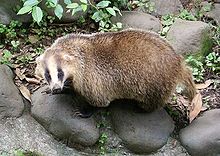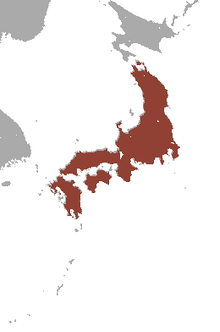- Japanese badger
-
Japanese badger 
Meles anakuma at Inokashira Park Zoo (Main Park), Tokyo, Jun 2009 Conservation status Scientific classification Kingdom: Animalia Phylum: Chordata Class: Mammalia Order: Carnivora Suborder: Caniformia Family: Mustelidae Subfamily: Mustelinae Genus: Meles Species: M. anakuma Binomial name Meles anakuma
Temminck, 1844
Japanese Badger range The Japanese badger (Meles anakuma) is a species of carnivoran of the family Mustelidae, the weasels and their kin. It is endemic to Japan, where it is found on Honshu, Kyushu, Shikoku,[2] and Shodoshima.[1] Japanese badgers are smaller (average length 79 cm in males, 72 cm in females) and less sexually dimorphic than their Asian counterparts.
Contents
Origin
The absence of badgers from Hokkaido, and the presence of related M. leucurus in Korea, suggest that the ancestral badgers reached Japan from the southwest via Korea.[1] Genetic studies indicate that there are substantial differences between Japanese and Asian badgers, which were formerly considered conspecific, and that the Japanese badgers are genetically more homogenous.[1]
Habits
Japanese badgers are nocturnal and hibernate during the coldest months of the year.[1] Beginning at 2 years of age, females mate and give birth to litters of two or three cubs in the spring (March-April). They mate again shortly afterwards, but delay implantation until the following February.[1] Japanese badgers are more solitary than European badgers; they do not aggregate into social clans, and mates do not form pair bonds. During mating season, the range of a male badger overlaps with those of 2 to 3 females.[1]
Habitats
Japanese badgers are found in a variety of woodland and forest habitats.[1]
Diet
Japanese badgers have an omnivorous diet that includes worms, beetles, berries and persimmons.[1]
Threats
Although they remain common, their range has shrunk recently.[1] They presently range over about 29 per cent of the country, an area that has shrunk 7 per cent over the last 25 years.[1] Increased land development and agriculture, as well as competition from introduced raccoons are threats. Hunting is legal but has declined sharply since the 1970s.[1]
References
- ^ a b c d e f g h i j k l Kaneko, Y. & Sasaki, H. (2008). "Meles anakuma". IUCN Red List of Threatened Species. Version 2009.1. International Union for Conservation of Nature. http://www.iucnredlist.org/apps/redlist/details/136242. Retrieved 17 August 2009.
- ^ Wozencraft, W. Christopher (16 November 2005). "Order Carnivora (pp. 532-628)". In Wilson, Don E., and Reeder, DeeAnn M., eds. Mammal Species of the World: A Taxonomic and Geographic Reference (3rd ed.). Baltimore: Johns Hopkins University Press, 2 vols. (2142 pp.). p. 611. ISBN 978-0-8018-8221-0. OCLC 62265494. http://www.bucknell.edu/msw3/browse.asp?id=14001276.
Categories:- IUCN Red List least concern species
- Badgers
- Mammals of Asia
- Mammals of Japan
- Animals described in 1844
Wikimedia Foundation. 2010.

